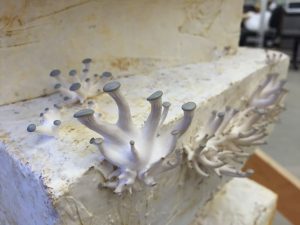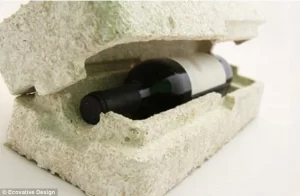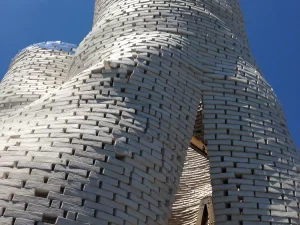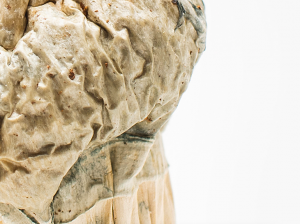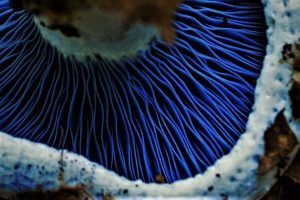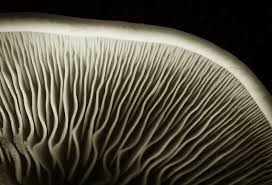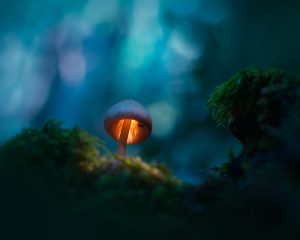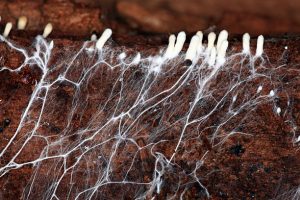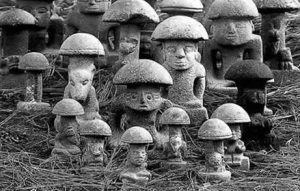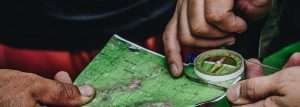Mushrooms, those heroes.
For thousands of years, mushrooms have been highly regarded for their nutritive, healing and hallucinogenic properties. These inconspicuous organisms flourish around the world in an unbelievable variety of habitats. They are unique problem-solvers, they saved life on Earth millions of years ago, and continue to do so.
Today, with the therapeutical potential of psychedelics being re-explored by scientists, magic mushrooms, and their special compound psilocybin, are at the forefront of an amazing journey for mental health and mind-expansion. Practices such as micro-dosing and psychedelic-therapy are offering alternatives to antidepressant medications.
Fortunately, it is not only the fruit mushroom that is amazing but also the root network: the mycelium. Mycelium has an incredible and diversified potential for environmental solutions; innovative fungal-derived methods are offering promising solutions to devastating worldwide issues such as plastic and heavy metal pollution, agricultural and construction waste, saturated landfills and excessive bovine production.
Mycelium to the rescue.
When the worldwide population is estimated to climb to 10 billion by 2050, that a majority of of the billion of tons we produce is going to waste while billion of people are kept unnourished, when our soils are eroding and our ways of producing, distributing, and consuming food and materials are reaching an indecent peak, how will we be able to sustainably inhabit the planet?
Under our radar, the humble single-celled worker that keeps our soil together, active and healthy: mycelium, the trailblazer of life as we know it.
Fortunately, in the last decade, methods involving the filamentous roots of fungi have shown promising performance in various fields: from acting as a natural insecticide to replacing plastic packaging, from serving as natural scaffolding for growing organs to mushroom base building materials, are we entering a mycelium era? Can mycelium help clean our Planet?
Mycelium: an underground network of fungal threads.
Mycelium is the vegetative underground part of the fungus, made of a network of fine white filaments (hyphae) that act as roots. Hyphae, from the Greek root “huphé”, meaning “web”, are the filamentous tubes of the mycelium that grow into food sources. They are like stomach: they digest other organisms to get energy that they can then pass onto those who need it in exchange for nutrients they need.
The ability of these underground fibrils includes seeking for food, facilitating microfiltration, absorbing nutrients, and serving as an organic filter for soil and water. By breaking down organic matter it feeds on, mycelium regenerates the soil by ridding the ground of any pollutants. The biomass it breaks down turns into compost that feeds the plants around it.
Mycelium, when hardened, turn into sclerotium. Sclerotia are a compact reserve of nutrients whose role is to survive environmental extremes. Magic mushrooms such as Psilocybe mexicana, Psilocybe tampanensis, Psilocybe mammillata, or Psilocybe semilanceata produce them. They can be called Truffles or Philosophers’ stone and consumed for their entheogenic properties. Some consumers describe the trip on truffles as very different from that of the fruiting body; overall milder but more difficult on the stomach if consumed straight.
The mycelial network: the biggest living organism on Earth.
American mycologist Paul Stamets estimated that within one inch of soil, there could be about 8 miles of mycelium. The Humongous Fungus from Oregon’s Blue Mountains occupies about 2,384 acres of soil, the equivalent of nothing less than 1,665 football fields, and is estimated to be about 8650 years old. This makes mycelium, the biggest living organism on Earth.
Couple of hundreds of million years ago, these microscopic life forms even developed into giant mushrooms. On the Arab peninsula, archeologists found a fossil they initially thought was a tree. It turned out to be an 8-meter-high mushroom that grew 500 million years ago… How can mycelium grow so large, so fast and last so long?
A network of self-learning fungal fabric.
Paul Stamets likes to describe mycelium as a highly sensitive living organism, aware of our movement and following our trails from the forest floor where it resides. He says that each step we take is like an imprint in the fungal fabric, that mycelium knows where we are, and that it follows us in hopes of nutritive opportunities (like that twig that you will step on and break, and that it will devoure).
Moreover, these underground mycelial membranes are said to have the capacity to pick up knowledge and are highly adaptive to catastrophe. It was observed that some hyphae tubes act as arteries that guide, they organize the flow and direction of the other hyphae according to their mapped knowledge. Another particularity of mycelium is that it’s one of the rare organisms that damage services; when it is cut, it blooms into a mushroom.
To this day, the mycelial network architecture and dynamics cease to intrigue. Some experts see a strange conformity in the organizational archetype of mycelium to that of neurons, computer networks, or even, the Universe.
So what gives mycelium that ability to navigate nutrients on such large distance through the forest’s underground tissue?
Symbiosis between plant and fungi.
The ability of mycelium to integrate the roots of plants and connect the underground tissues to help navigate nutrients on long distances is essential for the forest’s balance. Others have compared mycelium to an underground world wide web, or wood wide web, where plants and fungi exchange and support each other in their weaknesses. This underground mycorrhizal symbiosis network makes fungi and mycelium the link between plants and animals. Animals couldn’t digest and process nutrients if it wasn’t for the fungi present in their gut, while plants couldn’t survive in a soil they can’t synthesize. Fungi couldn’t thrive if it wasn’t for the nutrients provided by the photosynthesis of plants and soil wouldn’t exist if it wasn’t for fungi breaking down the matter into new soil. This mutualistic relationship is one of the most important contracts out there as it ensures our soils to stay healthy, and for plants to continue doing what they do best: make our lives possible by producing oxygen. This contract is the energy of life cycles.
Mushrooms as scaffolding structure to grow human tissue.
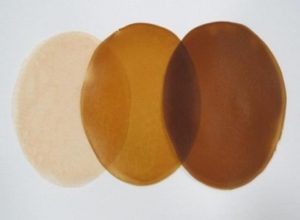
Mycelium to treat soil contamination.
Back in 1998, scientists had found that oyster mushrooms can grow on heavily oil-contaminated soils. After 8 weeks, 99% of the hazardous waste had broken down. Their ability to chop down into fragments is what helps the process of making dangerous materials less dangerous. They can help clean soils polluted with lead, arsenic, and mercury from mining operations. Considering there is an estimated 5 million oil-contaminated sites worldwide releasing one of the world’s most worrying pollutants of our age, PAH polycyclic aromatic hydrocarbons, which kills flora, fauna , damage organs, and can cause cancer in humans and animals, we can agree, we need the fungi.
In Chernobyl, where soils are to this day radioactive after the nuclear power plant exploded back in 1986, scientists used mushrooms in a mycorrhizal relation with sunflowers to treat soil contamination. After twelve weeks, they had grown to absorb the radioactivity present in the soil. The radioactive sunflowers were then burned and disposed of. Using the right mushroom in connection to the complexity of each ecosystem takes time and patience and often remediation schemes are not impeccable enough to be endorsed by authorities.
Mycelium-based protective packaging.
Because it can shape into any mould, can fill that space at a fast pace, mycelium has been used to make ecological protective packaging. From one spore in a mould it flourishes and devours whatever is in there.
In that optic, fungal-derived methods are well suited for industrial processes; they grow at an exponential growth curve, as a “set and forget” process: one cell becomes two, becomes three, and five etc.. Mycelium’s reproductive pace stunningly fits the time frame and scale of the manufacturing environment, it is cheaper to produce than plastic or bovine leather and it eats waste as it does it!
Mycelium-based building bricks.
It is important to remind that fungi are amongst the few organisms that can significantly break down lignin, that robust component present in wood and plant cells. This is what inspired unusable agricultural residue from corn (a great nutritional source for fungi) to be up-cycled into building bricks for instance. The mycelium uses the corn residue to grow itself!
In Delhi India, where crops are burned and participate in air pollution, mycelium has been put to the test to devour the agricultural waste instead. The result is a lightweight and strong mycelium bricks made out of decomposed organic waste. The product is not flammable and has extremely good insulation properties.
The mycelium specie used for these types of processes are from mycorrhizal fungi, that grow on or in relation to trees. The mycorrhizal mycelium is a favoured candidate in bioengineering as it is compatible with a variety of other materials it is mixed with, such as bamboo.
Below, details of a mushroom-based construction presented at the MOMA PS1 in New York.
Mushroom-based leather and meat.
While our population is expected to raise to 10 billion by 2050, alongside, the worldwide meat consumption is most likely expected to attempt to follow. Myco-proteins, which are fungi and soy-based, are showing great ability to imitate meat texture. Even though many consumers aren’t ready to let go of their beloved tasty bacon, these sustainable alternatives might be the little breath of fresh air that can relieve the pressure on bovine.
The environmental imprint of the bovine industry is disastrous. Mycelium-based leather emits fewer greenhouse gases and uses much less water and resources than animal leather .
Mycelium rescues over-run soils.
Soil-destructive agricultural methods such as industrial farming and clearcutting disturb the soil and destroy the mycelium, sucking them dry of their nutrients, bacteria and natural symbiosis. Agricultural production is largely dependent on the condition of the soil. If there is no interaction with fungi, plants grow far less well. Reimplementing mycelium into the earth has helped re-energize the symbiosis.
Mushrooms grow all over the world, therefore, it is possible to choose the mycelium specimen accordingly to the local ecosystem.
The exploits of mushrooms.
With accelerating climate change and pollution is increasing the pressure on our ecosystems, methods that work with Nature, for Nature are vital. Now that we finally discovered that trees communicate, that bees are vital to our survival, that mushrooms aren’t plants, and that engineering that mimicks nature is the way to go, bio-based materials are offering an ecological solution.
After all, mushrooms are our allies.. They gave us penicillin, LSD, psilocybin, they can purify air, water and soil, they can eat bio-waste and oil, they work with 95% of plants to help absorb radioactivity, they can imitate meat and leather consistency, they can serve as scaffolding for growing human tissue, and they comply to any shape. Mushrooms for medicine, mushrooms for bacon, mushrooms for packaging, mushroom for building, mushroom for energy, mushroom for everything!



